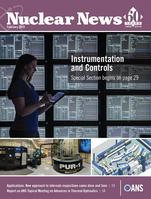The School of Nuclear Engineering is proud to be featured on two covers of Nuclear News published by the American Nuclear Society.
A special section on Health Physics and Isotopes & Radiation in the June 2019 issue focuses on researchers at Purdue University and Oak Ridge National Laboratory collaborating on a DOE-funded project to produce and test and a low-cost, lightweight neutron spectrometer/dosimeter.
"The research team at Purdue included Taleyarkhan; Anthony Sansone, a doctoral student; Brian Archambault, a consultant working for Sagamore Adams Laboratories (a venture capital start-up that had a limited-term arrangement with Purdue’s Office of Technology Commercialization through 2018); Thomas Grimes, who contributed to the project as a postdoctoral researcher before joining the staff of Pacific Northwest National Laboratory; Alexander Hagen, a former doctoral student now also employed at PNNL; and several undergraduates. Their task was to design, develop, construct, and test the H*TMFD hardware and software and develop control and data acquisition software to compare dose predictions from H*TMFD against an industry-standard neutron dosimeter: the lithium iodide Bonner sphere spectrometry system (LiI- BSS), which has been in use for over 60 years."
Full article
In the same section of the June 2019 issue, Niowave, owned by Dr. Terry Grimm (BSNE ’87), is also highlighted as being one of four U.S companies leading the way in providing a commercial supply of the widely used medical radioisotope, Mo-99.
"Founded in 2005 as a spin-off from Michigan State University’s Facility for Rare Isotope Beams, Niowave is involved in the research, design, manufacturing, and operation of superconducting electron linear accelerators. Currently, the company is building production facilities in the Lansing area in hopes of capturing a significant fraction of the existing medical imaging market.
The company’s process of producing Mo-99, known as the LEU-Modified Cintichem Process, uses accelerator-based neutron generation to fission uranium from LEU targets, without the need for nuclear reactors or HEU. Niowave has produced small quantities of Mo-99 and other isotopes under its NRC materials license, and the company said it will seek additional amendments to its license as it scales up production and expands to other facilities. Niowave plans to have only 99 kilograms of LEU enriched to 9.75 percent U-235 at its production facility. By keeping the quantity and enrichment of LEU below this threshold, the company said it avoids the NRC’s stricter physical protection and nuclear material control and accounting system requirements. The company is aiming at beginning commercial production by 2025 in a facility that can produce 1,550 six-day Ci per week, with a second facility with the same capacity to open by 2027.
In addition to Mo-99 production, Niowave will harvest other beta-emitting radioisotopes for sale to medical, research, and pharmaceutical organizations, including strontium-89, praseodymium-143, neodymium-147, promethium-149, and iodine-131. The company is also able to produce alpha emitters using radium targets. Niowave said that its NRC license and its expertise in superconducting electron linear accelerators will position the company to take the lead in producing alpha- and beta-emitters for cancer therapies. Sales of the additional isotopes are expected to support Niowave’s operating and expansion costs."
In the February 2019 issue, PUR-1's fully digital I&C installation was featured.
"PUR-1 is now poised to pave the way for future nuclear engineers in teaching and research. The College of Engineering is driven to deliver in three principal areas, all of which PUR-1 is now in a position to perform. At the interface of virtual and physical engineering lies the principal source of efficiency improvements, con-centration of cybersecurity vulnerabilities, and potential failure modes. PUR-1 will study and develop ways in which this interface can become an asset to the resiliency and risk assessment engineer.
The large pool of premier engineering talent is growing rapidly through online learning, diversity of background, and innovative cross-discipline studies. From this expansive population of students, nuclear engineers will grow and thrive to deliver solutions to today’s most pressing issues. Finally, as the university continues to strengthen its industry partnerships in all areas, including curriculum innovation, workforce development, research impact, and entrepreneurship, the work being done at PUR-1 will have a rapid and lasting impact in the field.


